NGC Ancients: Collecting Byzantine Coins on a Budget
Posted on 6/11/2019
As we discovered in the previous two columns, the fields of ancient Greek and Roman coins provide the budget-minded collector with opportunities perhaps unequaled in any other area of numismatics.
This month we’ll continue the discovery with Byzantine coins, which in truth are not ‘ancients’ at all, but are Dark Age and Medieval coins. However, the collecting tradition has attached them to ancient coinage because the Byzantine Empire was the seamless continuation of the fallen Roman Empire.
As in the previous two columns, we’ll focus on coins available for $100 or less, and we’ll start with group lots sold in recent online auctions. Below are four examples.
 |
The nine coins pictured here – all pleasant, albeit worn, Byzantine bronzes – sold for a touch less than $120, making them about $13.50 per coin.
 |
This interesting lot of seven coins includes five copper pieces, one billon scyphate (cup shaped) coin, and a small copper coin of the Vandals in Carthage. The coins date from the 6th through the 12th Centuries A.D. The lot realized about $165, breaking down to less than $24 per coin.
 |
The five pleasant Byzantine coins offered in this group pictured above range in date from the 6th through the 12th Centuries A.D. Four are copper and one is billon. The lot realized a touch more than $190, or about $38 per coin.
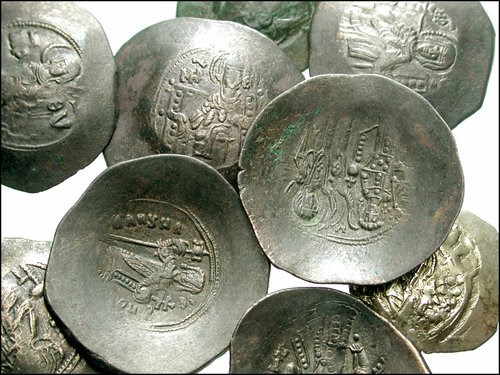 |
The above group of nine scyphates includes issues produced from the 12th through the 14th Centuries A.D. The lot fetched slightly more than $380, working out to about $43 per coin – not bad considering the coins are of good quality and one is gold.
Now, we’ll continue with some individual coins.
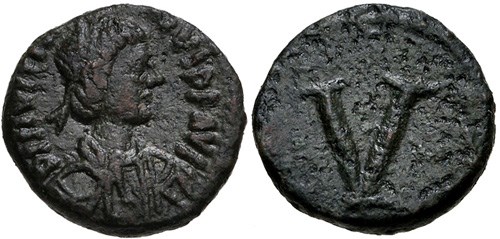 |
The bronze of Justinian I (A.D. 527-565), above, shows the emperor’s portrait and a large V, which indicates its denomination as a pentanummium (five-nummi coin). Struck at an uncertain Byzantine mint, it realized about $70.
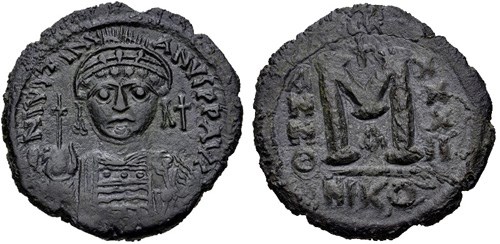 |
Another copper coin of Justinian I, shown above, is a follis with a facing portrait of the emperor. The large M on its reverse indicates its value as 40 nummi (follis). A great deal of other information is also recorded on the reverse, including that it was struck at the first officina (workshop) of the Nicomedia mint in the 32nd year of Justinian’s reign (558/9). It realized about $77.
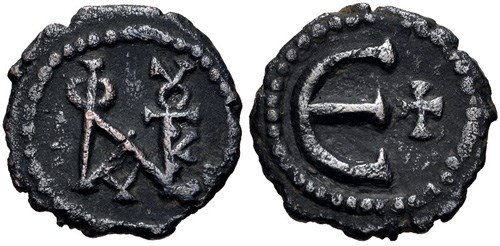 |
This pentanummium of Justin II (A.D. 565-578) does not bear a portrait on its obverse, but rather a monogram of the emperor and his wife-empress Sophia. The reverse features a large E, the Greek equivalent of the number five (thus, five nummi); the pentanummium of Justinian I shown earlier bore a V, the Latin equivalent of five. This well-struck piece fetched $65.
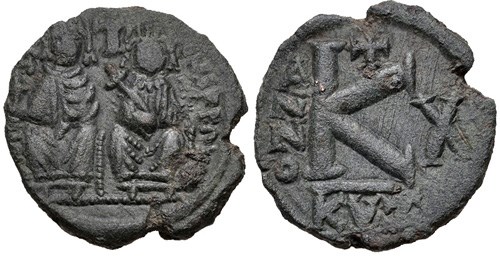 |
Above is a half-follis (20-nummi) of Justin II, who is shown enthroned with his wife-empress, Sophia. The large K on the reverse indicates that it is a 20-nummi coin; also revealed is that it was minted at Cyzicus in the tenth year of the reign (574/5). It sold for about $70.
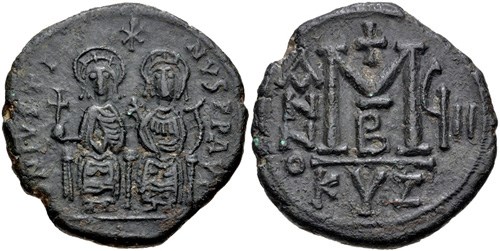 |
Shown above is a third bronze of Justin II, this one a full follis (40-nummi) struck at the second officina at the Cyzicus mint during the eighth year (572/3) of his reign. A very attractive coin, it fetched less than $90.
 |
The half-follis of Tiberius II Constantine (A.D. 578-582) shown above is of a charmingly crude style. Its denomination of 20-nummi is indicated by the Latin formula XX. Though not dated, the reverse indicates it was struck in the fourth officina of the Constantinople mint. It sold for a touch less than $60.
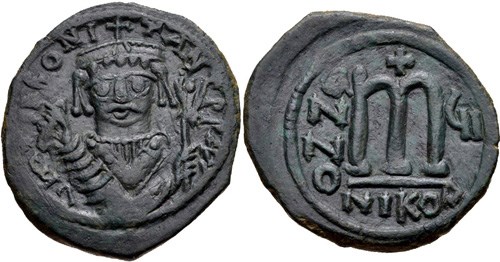 |
Above is an equally crude coin of Tiberius II Constantine. This one is a follis, with the Greek M indicating 40 nummi. The reverse indicates it was struck at Nicomedia at the second officina during the emperor’s seventh regnal year (580/1). A very attractive coin, it fetched slightly more than $70.
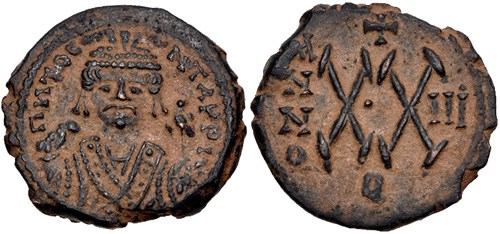 |
Above is a copper half-follis of Maurice Tiberius (A.D. 582-602) struck at the Antioch mint in the emperor’s third regnal year (584/5). With its attractive and desirable red-dirt patina, this piece realized about $95.
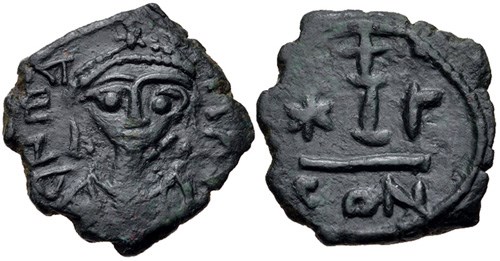 |
A second coin of Maurice Tiberius, the decanummium shown above, was struck at the third officina of the Constantinople mint. It is exceptionally crude, which imbues it with great charm for Byzantine enthusiasts. It sold for nearly $60.
 |
Above is a third coin of Maurice Tiberius, a follis of the first officina of the Cyzicus mint. It rivals the previous for the crudeness of its die work. Dated to the emperor’s eighth regnal year (589/90), it realized about $83.
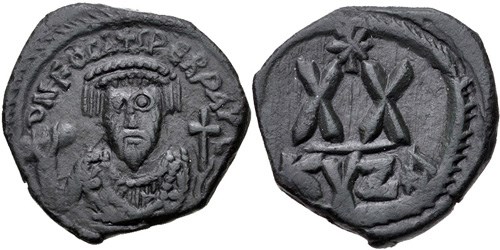 |
The half-follis of Phocas (A.D. 602-610) above was struck at the first officina of the Cyzicus mint. Although an excellent example with an unusually strong strike, it sold for less than $83. It shows how inexpensive a quality Byzantine bronze can be.
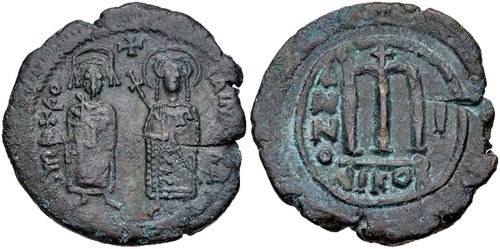 |
The follis of Phocas shown above portrays the emperor as a figure standing with his wife and empress, Leontia. It was struck at the second officina of the Nicomedia mint in the emperor’s first regnal year (602/3). It realized about $77.
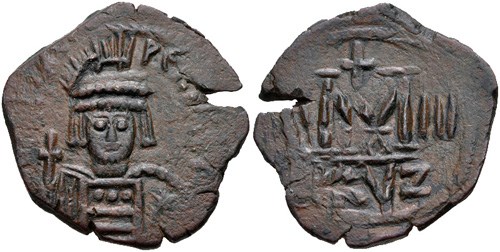 |
The follis of Heraclius (A.D. 610-641) shown above was struck at the first officina of the Cyzicus mint during the emperor’s third regnal year (612/3). It’s an especially crude item, and charming thus. It fetched about $95.
 |
The follis of the emperor Theophilus (A.D. 829-842) above bears no mintmark or date, but is attributed to the Constantinople mint. With a bold, sharp portrait, it realized just under $90.
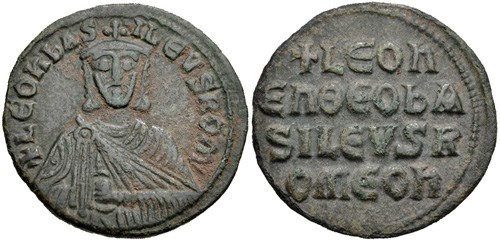 |
Above is a copper follis of Leo VI ‘the Wise’ (A.D. 886-912) from the Constantinople mint. The portrait is formal, and typical of the period. It sold for about $77.
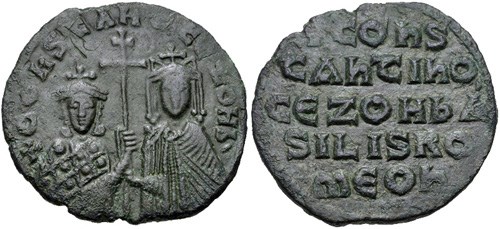 |
The follis above shows the half-length effigies of the emperor Constantine VII (A.D. 913-959) and his mother-empress Zoe. Struck early in his reign, c. 914-919, it fetched less than $55.
 |
From about A.D. 970 to 1092, Byzantine emperors issued large quantities of copper folles bearing the image of Jesus Christ in place of their own, thus the term ‘anonymous folles’ for the series. This one, attributed to the period A.D. 976-1035, realized about $100.
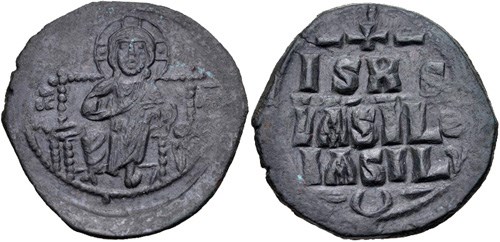 |
The anonymous follis shown above depicts Christ enthroned and is attributed to the period A.D. 1042-1060. The Greek inscription on its reverse translates to “Jesus Christ, King of Kings.” A highly detailed piece, it sold for about $77.
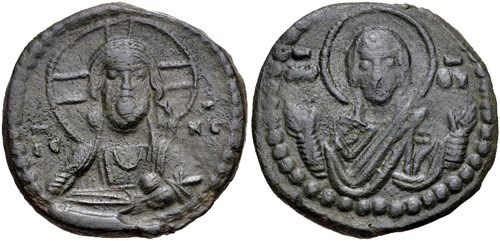 |
Above is an anonymous follis attributed to the period A.D. 1065-1071. It’s an unusual type since it shows not only the facing bust of Christ, but also that of the Virgin Mary, with her arms raised (orans). An excellent example of the type, it fetched about $88.
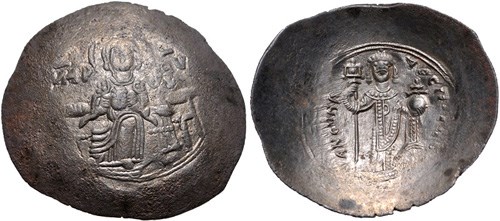 |
Shown above is a cup-shaped (scyphate) billon aspron trachy of the emperor Manuel I ‘Comnenus’ (A.D. 1143-1180). It pairs the enthroned figure of the Virgin Mary holding the infant Jesus with the standing figure of the emperor. A decent example of the type, it realized about $65.
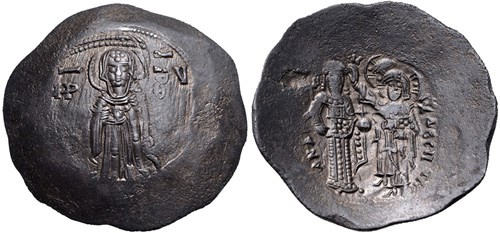 |
Above is another scyphate billon aspron trachy – this one of the emperor Andronicus I ‘Comnenus’ (A.D. 1183-1185). It also shows the enthroned figure of the Virgin Mary holding the infant Jesus, but pairs it with the standing figure of the emperor being blessed by Christ. A pleasant coin, it realized nearly $90.
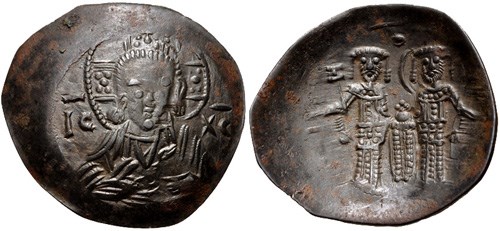 |
Struck under the emperor Alexius III ‘Angelus-Comnenus’ (A.D. 1195-1203), the billon aspron trachy above portrays a child-Christ (Christ Emmanuel) and shows the standing figures of the emperor and St. Constantine. A clear example of the type, it sold for nearly $90.
The next four coins all realized more than $100 at auction, but considering they are, by nature, more expensive pieces, they’re worth sharing, even in an article devoted to budget buying.
 |
Above is a silver hexagram issued by the emperors Heraclius and Heraclius Constantine (A.D. 613-641). A thick silver piece, it shows on its obverse the two emperors seated, and on its reverse a cross on a globe and three steps. It realized about $130.
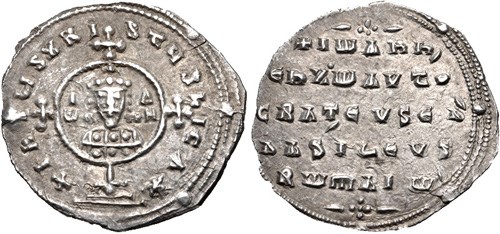 |
Shown above is a silver miliaresion of John I (A.D. 969-976). It’s a thin, silver coin with the emperor’s portrait set upon a medallion attached to a cross crosslet. The reverse bears an imperial inscription. It also sold for about $130.
 |
Byzantine emperors struck many gold coins, but due to their intrinsic value they typically are among the more valuable coins in the series. However, occasionally they can be found inexpensively. The gold tremissis shown above, issued by Justinian I, realized less than $120.
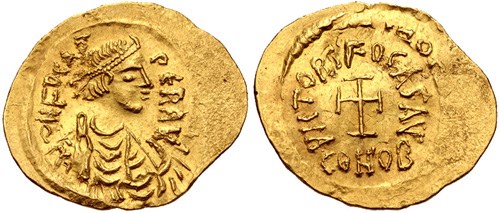 |
Our last featured piece is the gold tremissis of Phocas shown above. Except for some inconsequential double-striking, it’s a bold, mint state piece, which realized about $225.
Interested in reading more articles on Ancient coins? Click here
Images courtesy of Classical Numismatic Group.
Stay Informed
Want news like this delivered to your inbox once a month? Subscribe to the free NGC eNewsletter today!